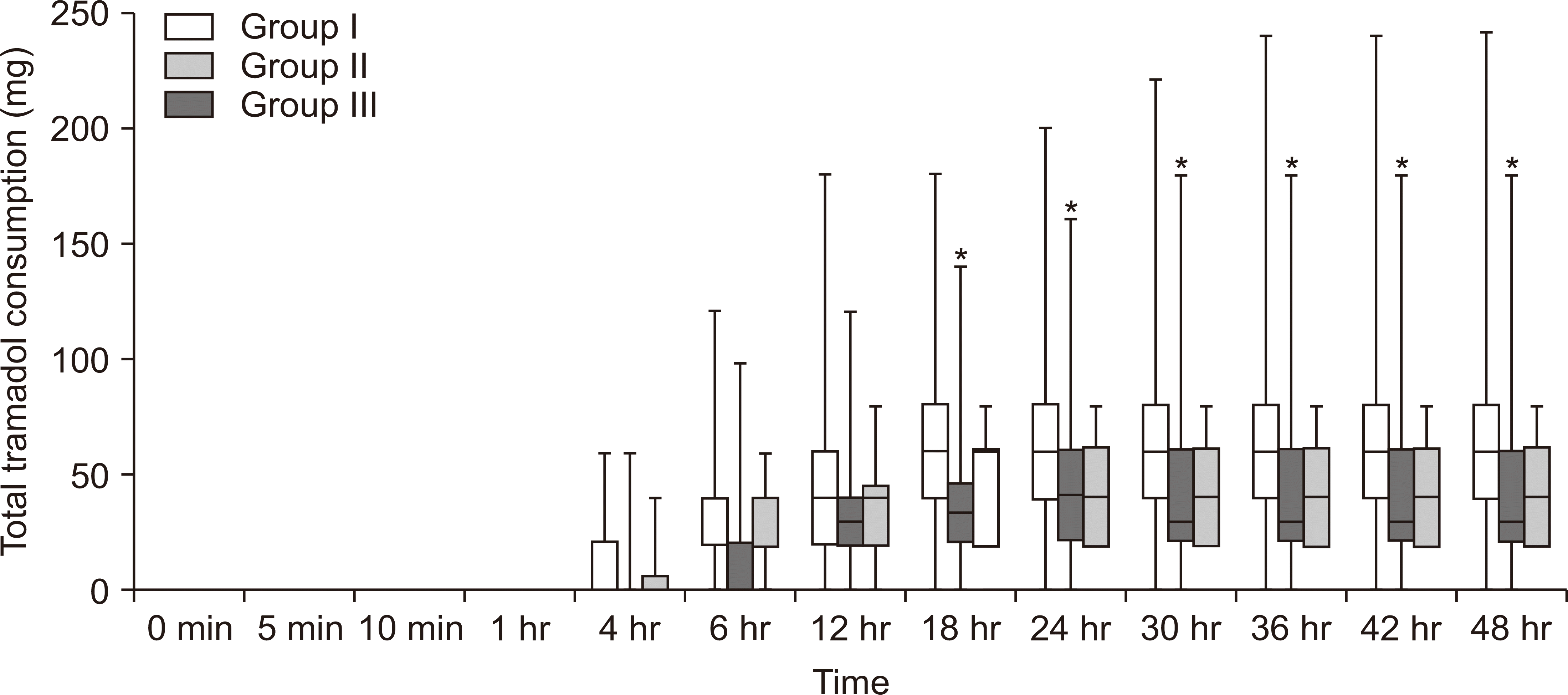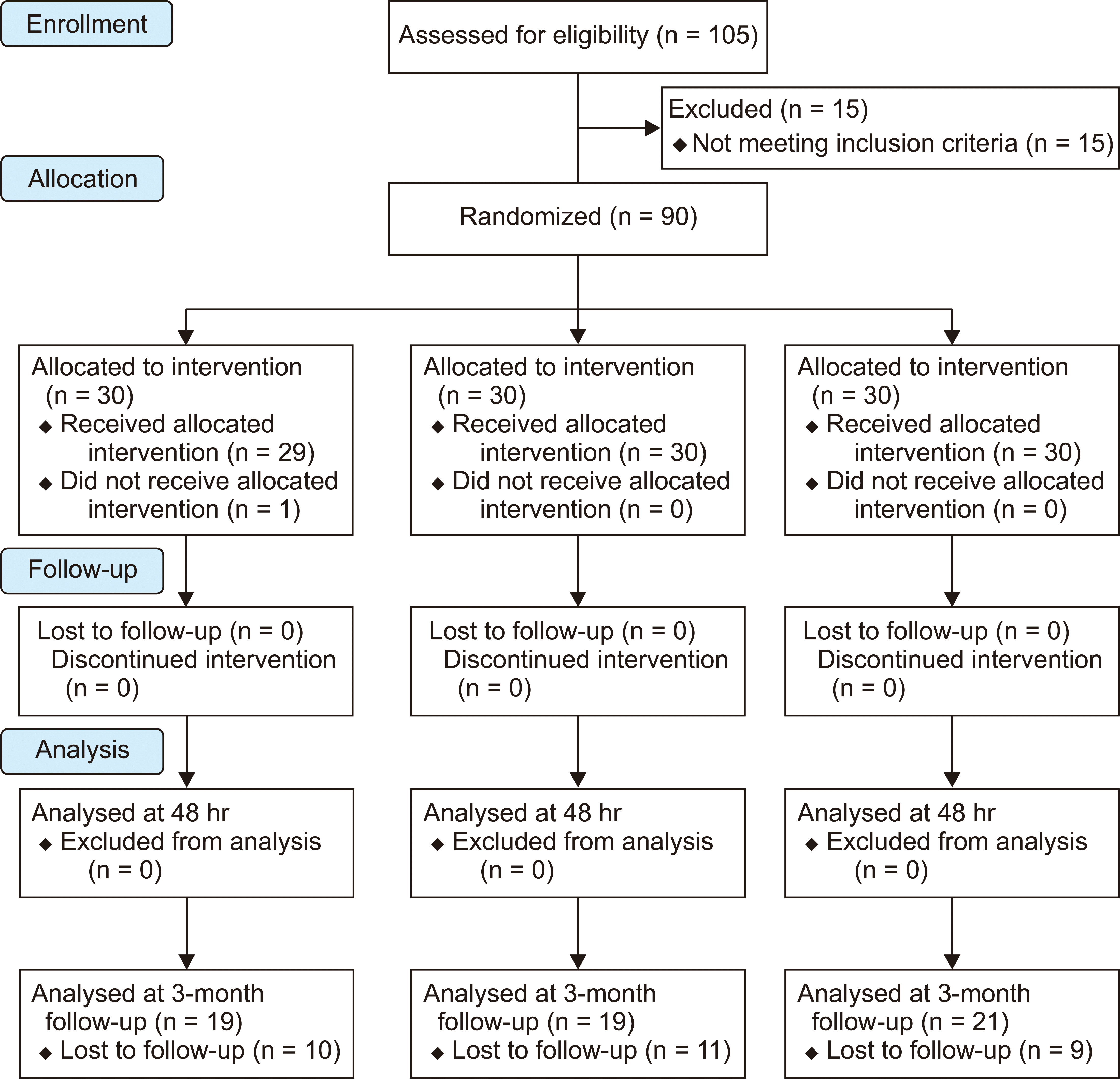1. Jones J Jr, Southerland W, Catalani B. 2017; The importance of optimizing acute pain in the orthopedic trauma patient. Orthop Clin North Am. 48:445–65. DOI:
10.1016/j.ocl.2017.06.003. PMID:
28870305.

2. Wiznia DH, Zaki T, Leslie MP, Halaszynski TM. 2018; Complexities of perioperative pain management in orthopedic trauma. Curr Pain Headache Rep. 22:58. DOI:
10.1007/s11916-018-0713-5. PMID:
29987515.

3. Gadsden J, Warlick A. 2015; Regional anesthesia for the trauma patient: improving patient outcomes. Local Reg Anesth. 8:45–55. DOI:
10.2147/LRA.S55322. PMID:
26316813. PMCID:
PMC4540140.

5. Sites BD, Antonakakis JG. 2009; Ultrasound guidance in regional anesthesia: state of the art review through challenging clinical scenarios. Local Reg Anesth. 2:1–14. DOI:
10.2147/LRA.S3444. PMID:
22915860. PMCID:
PMC3417939.

6. Davies AF, Segar EP, Murdoch J, Wright DE, Wilson IH. 2004; Epidural infusion or combined femoral and sciatic nerve blocks as perioperative analgesia for knee arthroplasty. Br J Anaesth. 93:368–74. DOI:
10.1093/bja/aeh224. PMID:
15247111.

7. Lollo L, Bhananker S, Stogicza A. 2015; Postoperative sciatic and femoral or saphenous nerve blockade for lower extremity surgery in anesthetized adults. Int J Crit Illn Inj Sci. 5:232–6. DOI:
10.4103/2229-5151.170846. PMID:
26807391. PMCID:
PMC4705568.

8. YaDeau JT, Paroli L, Fields KG, Kahn RL, LaSala VR, Jules-Elysee KM, et al. 2015; Addition of dexamethasone and buprenorphine to bupivacaine sciatic nerve block: a randomized controlled trial. Reg Anesth Pain Med. 40:321–9. DOI:
10.1097/AAP.0000000000000254. PMID:
25974277. PMCID:
PMC4470755.
10. Kauppila T, Kemppainen P, Tanila H, Pertovaara A. 1991; Effect of systemic medetomidine, an alpha 2 adrenoceptor agonist, on experimental pain in humans. Anesthesiology. 74:3–8. DOI:
10.1097/00000542-199101000-00002. PMID:
1670912.

11. Thapa D, Ahuja V, Pandey K, Gombar S, Gupta R. 2019; Evaluation of analgesic efficacy of dexmedetomidine as adjuvant with ropivacaine in ultrasound-guided adductor canal block in patients following anterior cruciate ligament reconstruction surgeries. Br J Pain. 13:91–8. DOI:
10.1177/2049463718796865. PMID:
31019690.

12. Gaumann D, Forster A, Griessen M, Habre W, Poinsot O, Della Santa D. 1992; Comparison between clonidine and epinephrine admixture to lidocaine in brachial plexus block. Anesth Analg. 75:69–74. DOI:
10.1213/00000539-199207000-00013. PMID:
1616165.

13. Miaskowski C, Crews J, Ready LB, Paul SM, Ginsberg B. 1999; Anesthesia-based pain services improve the quality of postoperative pain management. Pain. 80:23–9. DOI:
10.1016/S0304-3959(98)00192-4. PMID:
10204714.

14. Carney J, McDonnell JG, Ochana A, Bhinder R, Laffey JG. 2008; The transversus abdominis plane block provides effective postoperative analgesia in patients undergoing total abdominal hysterectomy. Anesth Analg. 107:2056–60. DOI:
10.1213/ane.0b013e3181871313. PMID:
19020158.

16. Fukuda TY, Fingerhut D, Moreira VC, Camarini PM, Scodeller NF, Duarte A Jr, et al. 2013; Open kinetic chain exercises in a restricted range of motion after anterior cruciate ligament reconstruction: a randomized controlled clinical trial. Am J Sports Med. 41:788–94. DOI:
10.1177/0363546513476482. PMID:
23423316.

17. Holdgate A, Asha S, Craig J, Thompson J. 2003; Comparison of a verbal numeric rating scale with the visual analogue scale for the measurement of acute pain. Emerg Med (Fremantle). 15:441–6. DOI:
10.1046/j.1442-2026.2003.00499.x. PMID:
14992058.

18. Trein TA, Floriano BP, Wagatsuma JT, Ferreira JZ, da Silva GL, Dos Santos PS, et al. 2017; Effects of dexmedetomidine combined with ropivacaine on sciatic and femoral nerve blockade in dogs. Vet Anaesth Analg. 44:144–53. DOI:
10.1111/vaa.12399. PMID:
28237684.

19. Brummett CM, Hong EK, Janda AM, Amodeo FS, Lydic R. 2011; Perineural dexmedetomidine added to ropivacaine for sciatic nerve block in rats prolongs the duration of analgesia by blocking the hyperpolarization-activated cation current. Anesthesiology. 115:836–43. DOI:
10.1097/ALN.0b013e318221fcc9. PMID:
21666435. PMCID:
PMC3179561.

20. Lin YN, Li Q, Yang RM, Mao ZX, Liu JC. 2013; Addition of dexmedetomidine to ropivacaine improves cervical plexus block. Acta Anaesthesiol Taiwan. 51:63–6. DOI:
10.1016/j.aat.2013.06.001. PMID:
23968656.
21. Abdallah FW, Abrishami A, Brull R. 2013; The facilitatory effects of intravenous dexmedetomidine on the duration of spinal anesthesia: a systematic review and meta-analysis. Anesth Analg. 117:271–8. DOI:
10.1213/ANE.0b013e318290c566. PMID:
23632057.
22. Andersen JH, Grevstad U, Siegel H, Dahl JB, Mathiesen O, Jæger P. 2017; Does dexmedetomidine have a perineural mechanism of action when used as an adjuvant to ropivacaine?: a paired, blinded, randomized trial in healthy volunteers. Anesthesiology. 126:66–73. DOI:
10.1097/ALN.0000000000001429. PMID:
27792047.

23. Fritsch G, Danninger T, Allerberger K, Tsodikov A, Felder TK, Kapeller M, et al. 2014; Dexmedetomidine added to ropivacaine extends the duration of interscalene brachial plexus blocks for elective shoulder surgery when compared with ropivacaine alone: a single-center, prospective, triple-blind, randomized controlled trial. Reg Anesth Pain Med. 39:37–47. DOI:
10.1097/AAP.0000000000000033. PMID:
24317234.

24. Yoshitomi T, Kohjitani A, Maeda S, Higuchi H, Shimada M, Miyawaki T. 2008; Dexmedetomidine enhances the local anesthetic action of lidocaine via an alpha-2A adrenoceptor. Anesth Analg. 107:96–101. DOI:
10.1213/ane.0b013e318176be73. PMID:
18635472.

25. Nie Y, Liu Y, Luo Q, Huang S. 2014; Effect of dexmedetomidine combined with sufentanil for post-caesarean section intravenous analgesia: a randomised, placebo-controlled study. Eur J Anaesthesiol. 31:197–203. DOI:
10.1097/EJA.0000000000000011. PMID:
24463478.

27. Karol MD, Maze M. 2000; Pharmacokinetics and interaction pharmacodynamics of dexmedetomidine in humans. Best Pract Res Clin Anaesthesiol. 14:261–9. DOI:
10.1053/bean.2000.0081.

28. Lee S, Kim BH, Lim K, Stalker D, Wisemandle W, Shin SG, et al. 2012; Pharmacokinetics and pharmacodynamics of intravenous dexmedetomidine in healthy Korean subjects. J Clin Pharm Ther. 37:698–703. DOI:
10.1111/j.1365-2710.2012.01357.x. PMID:
22650799.

29. Peng K, Liu HY, Wu SR, Cheng H, Ji FH. 2015; Effects of combining dexmedetomidine and opioids for postoperative intravenous patient-controlled analgesia: a systematic review and meta-analysis. Clin J Pain. 31:1097–104. DOI:
10.1097/AJP.0000000000000219. PMID:
25654534.
30. Sinha C, Kumar A, Kumari P, Singh AK, Sharma S, Kumar A, et al. 2018; Comparison of two doses of dexmedetomidine for supraclavicular brachial plexus block: a randomized controlled trial. Anesth Essays Res. 12:470–4. DOI:
10.4103/aer.AER_33_18. PMID:
29962618. PMCID:
PMC6020586.

31. Brummett CM, Padda AK, Amodeo FS, Welch KB, Lydic R. 2009; Perineural dexmedetomidine added to ropivacaine causes a dose-dependent increase in the duration of thermal antinociception in sciatic nerve block in rat. Anesthesiology. 111:1111–9. DOI:
10.1097/ALN.0b013e3181bbcc26. PMID:
19858875. PMCID:
PMC2770892.

32. Weerink MAS, Struys MMRF, Hannivoort LN, Barends CRM, Absalom AR, Colin P. 2017; Clinical pharmacokinetics and pharmacodynamics of dexmedetomidine. Clin Pharmacokinet. 56:893–913. DOI:
10.1007/s40262-017-0507-7. PMID:
28105598. PMCID:
PMC5511603.

33. Vorobeichik L, Brull R, Abdallah FW. 2017; Evidence basis for using perineural dexmedetomidine to enhance the quality of brachial plexus nerve blocks: a systematic review and meta-analysis of randomized controlled trials. Br J Anaesth. 118:167–81. DOI:
10.1093/bja/aew411. PMID:
28100520.

34. Fisker AK, Iversen BN, Christensen S, Linde F, Nielsen KK, Børglum J, et al. 2015; Combined saphenous and sciatic catheters for analgesia after major ankle surgery: a double-blinded randomized controlled trial. Can J Anaesth. 62:875–82. DOI:
10.1007/s12630-015-0379-y. PMID:
25851020.

35. Joe HB, Choo HS, Yoon JS, Oh SE, Cho JH, Park YU. 2016; Adductor canal block versus femoral nerve block combined with sciatic nerve block as an anesthetic technique for hindfoot and ankle surgery: a prospective, randomized noninferiority trial. Medicine (Baltimore). 95:e5758. DOI:
10.1097/MD.0000000000005758. PMID:
28033291. PMCID:
PMC5207587.
36. Hu X, Li J, Zhou R, Wang Q, Xia F, Halaszynski T, et al. 2017; Dexmedetomidine added to local anesthetic mixture of lidocaine and ropivacaine enhances onset and prolongs duration of a popliteal approach to sciatic nerve blockade. Clin Ther. 39:89–97.e1. DOI:
10.1016/j.clinthera.2016.11.011. PMID:
27955918.

37. Rivara FP, Mackenzie EJ, Jurkovich GJ, Nathens AB, Wang J, Scharfstein DO. 2008; Prevalence of pain in patients 1 year after major trauma. Arch Surg. 143:282–7. DOI:
10.1001/archsurg.2007.61. PMID:
18347276.

38. Aaland MO, Marose K, Zhu TH. 2012; The lost to trauma patient follow-up: a system or patient problem. J Trauma Acute Care Surg. 73:1507–11. DOI:
10.1097/TA.0b013e31826fc928. PMID:
23147179.
39. Goldsmith H, Curtis K, McCloughen A. 2017; Incidence, intensity, and impact of pain in recently discharged adult trauma patients: an exploratory study. J Trauma Nurs. 24:102–9. DOI:
10.1097/JTN.0000000000000273. PMID:
28272183.








 PDF
PDF Citation
Citation Print
Print




 XML Download
XML Download